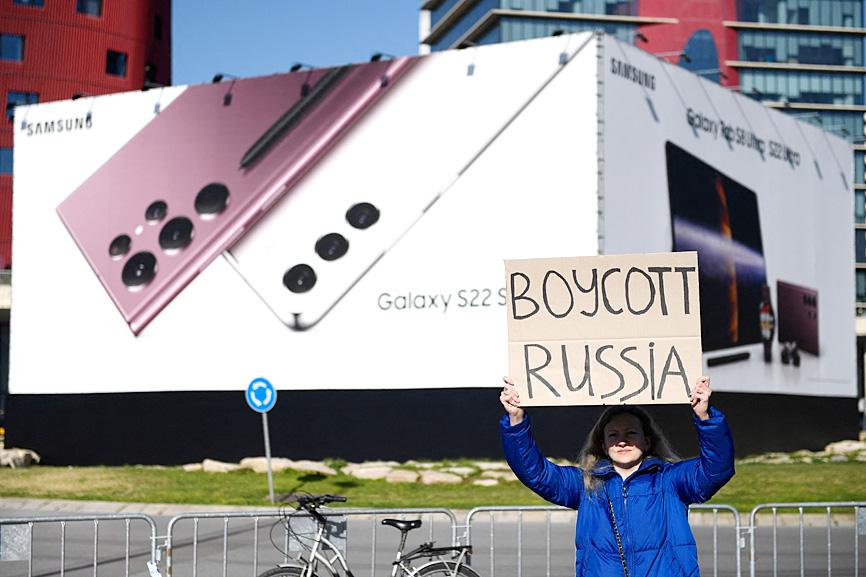Global smartphone production is expected to grow at a slower annual rate of 2.5 percent this year due to the sluggish seasonal demand in the first quarter, Russia’s invasion of Ukraine and COVID-19-related lockdowns of Chinese cities, market researcher TrendForce Corp (集邦科技) said on Friday.
Production is forecast to reach 1.366 billion units this year, down from the previous estimate of 1.38 billion units, the Taipei-based researcher said in a report.
However, as COVID-19-induced disruptions and semiconductor shortages linger, coupled with concerns about inflation and energy supply, smartphone production might be subject to further downward revisions later, it said.

Photo: AFP
“There are two key observations regarding the effects of the war on the smartphone market: First, brand sales have been suspended or have dropped sharply. Second, the war has exacerbated global inflation, which is strongly affecting energy and food prices in particular, and is rapidly spreading from Europe to the world,” the report said.
Mobile phone sales in Russia and Ukraine jointly account for approximately 3 to 4 percent of the global market, TrendForce data showed.
Eighty-five percent of sales in the two countries are in Russia, with Samsung Electronics Co, Xiaomi Corp (小米) and Apple Inc being the top three brands in the country, the data showed.
Samsung and Apple have announced the suspension of all exports to Russia, and it remains to be seen whether Chinese brands, including Xiaomi and Oppo Mobile Telecommunications Corp (歐珀), would be able to fill the void left by those two global brands in the short term, it said.
“If the war can be brought under control before the end of April, estimated impact on the smartphone market in 2022 will be approximately 20 million units,” the report said.
TrendForce said rising inflation would have an adverse effect on people’s disposable income, which would likely prolong the replacement cycle in the smartphone market.
“Due to inflation’s broad and profound influence, it is not yet possible to determine the extent of its effect on the global smartphone market, but there is indeed a high risk of downward revisions in the future,” the report said.
TrendForce believes that the COVID-19 pandemic remains a key factor to watch for in the smartphone market this year, especially in China, which continues to follow a “zero COVID-19” strategy.
“China, the world’s largest smartphone consumer market, is still adopting a dynamic zero COVID-19 policy. Not only will this policy exacerbate labor and material shortages in the intricate smartphone supply chain, pandemic prevention activities will also throw cold water on demand,” the report said.
As a result, China’s smartphone shipments would decline 7.7 percent annually to 300 million units this year from 325 million units last year, TrendForce said, adding that the possibility of a continued downturn cannot be ruled out.

TAKING STOCK: A Taiwanese cookware firm in Vietnam urged customers to assess inventory or place orders early so shipments can reach the US while tariffs are paused Taiwanese businesses in Vietnam are exploring alternatives after the White House imposed a 46 percent import duty on Vietnamese goods, following US President Donald Trump’s announcement of “reciprocal” tariffs on the US’ trading partners. Lo Shih-liang (羅世良), chairman of Brico Industry Co (裕茂工業), a Taiwanese company that manufactures cast iron cookware and stove components in Vietnam, said that more than 40 percent of his business was tied to the US market, describing the constant US policy shifts as an emotional roller coaster. “I work during the day and stay up all night watching the news. I’ve been following US news until 3am

UNCERTAINTY: Innolux activated a stringent supply chain management mechanism, as it did during the COVID-19 pandemic, to ensure optimal inventory levels for customers Flat-panel display makers AUO Corp (友達) and Innolux Corp (群創) yesterday said that about 12 to 20 percent of their display business is at risk of potential US tariffs and that they would relocate production or shipment destinations to mitigate the levies’ effects. US tariffs would have a direct impact of US$200 million on AUO’s revenue, company chairman Paul Peng (彭雙浪) told reporters on the sidelines of the Touch Taiwan trade show in Taipei yesterday. That would make up about 12 percent of the company’s overall revenue. To cope with the tariff uncertainty, AUO plans to allocate its production to manufacturing facilities in

Six years ago, LVMH’s billionaire CEO Bernard Arnault and US President Donald Trump cut the blue ribbon on a factory in rural Texas that would make designer handbags for Louis Vuitton, one of the world’s best-known luxury brands. However, since the high-profile opening, the factory has faced a host of problems limiting production, 11 former Louis Vuitton employees said. The site has consistently ranked among the worst-performing for Louis Vuitton globally, “significantly” underperforming other facilities, said three former Louis Vuitton workers and a senior industry source, who cited internal rankings shared with staff. The plant’s problems — which have not

COLLABORATION: Given Taiwan’s key position in global supply chains, the US firm is discussing strategies with local partners and clients to deal with global uncertainties Advanced Micro Devices Inc (AMD) yesterday said it is meeting with local ecosystem partners, including Taiwan Semiconductor Manufacturing Co (TSMC, 台積電), to discuss strategies, including long-term manufacturing, to navigate uncertainties such as US tariffs, as Taiwan occupies an important position in global supply chains. AMD chief executive officer Lisa Su (蘇姿丰) told reporters that Taiwan is an important part of the chip designer’s ecosystem and she is discussing with partners and customers in Taiwan to forge strong collaborations on different areas during this critical period. AMD has just become the first artificial-intelligence (AI) server chip customer of TSMC to utilize its advanced